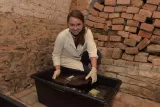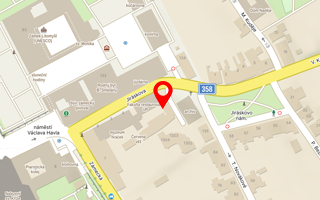Published: 25.02.2020
The world’s oldest well unearthed by archaeologists near Ostrov in the Chrudim area, Pardubice Region when doing construction works for the D35 motorway is far from resembling a source of water now. It has been disassembled into five parts which have been immersed – rather unusually – into sugar in plastic basins.
The restoration specialists have used something as simple as crystal sugar to preserve a 7000-old oak well. With no additives, crystal sugar works the best. A total of seven hundred one-kilo packets of sugar have been poured into 700 litres of water.
The wood is soaked with the solution of sugar. “At the moment, the well is undergoing impregnation. Each of the parts was cleaned and immersed in the solution of sacharosis,” says Karol Bayer, Vice-Dean of the Faculty of Restoration.
A combination of dark basement room, low temperature and high humidity creates perfect conditions for the well. It is not easy to preserve the wooden parts soaked with water. Unlike with standard wood, the oak components must be prevented from fully drying. If they dried, they would get deformed, and in fact destroyed.
“The preservation aims not only to solidify the well, but also to replace the water in the wood. As the wood dries, the sugar will do the job, which helps us preserve the well,” says Bayer.
For a long time, the restoration specialists have been been considering various options to treat and preserve the well, so that it could be displayed in the Museum of East Bohemia in Pardubice. “Never before have we have used sugar for preservation. That is why we discussed this option with specialists on wood preservation from the University of Chemistry and Technology Prague. The method used is the most convenient and least damaging one. Thanks to the method, the well will also preserve its original appearance,” says Bayer.
At first sight, the 7000-year-old wood was in good, but fragile condition. “If you think of how old it is, the condition of the wood is very good; it is, however, broken, so we must be extremely careful when handling it,” adds Bayer. The Neolithic people must have had some previous experience since the oak wood used is very durable and has good resistance. “This may explain why the well is in such a good condition,” says Bayer.
The technology used came as a surprise for the specialists
The restoration specialists were surprised at the quality of the woodworking. The structure of the well consists of grooved corner posts with inserted planks. The well is interesting also from the woodworking point of view.
“Up to now we have thought that when the first farmers came to our territory, they used rudimentary methods. The well reveals, however, that they brought with them a complete set of carpentry tools,” says Petr Juřina, manager of Archaia, a company that cooperated with Olomouc archeologists on the excavations for the D35 motorway. “If you imagine that we are talking about a period seven thousand years ago, it is very well carved,” says Marek Laška, a restoration student who is responsible for the well now. He makes sure that the wooden parts are fully immersed in the solution and that no microorganisms that may interfere with the preservation process get inside. The components will be immersed in the solution until November. Then they will be removed and will be drying for a few months. The well will not receive any further varnish or protective coating. Once this is over, it will be displayed in the Museum of East Bohemia in Pardubice.
The article has been originally published in the Pardubice Region supplement of the Mladá fronta DNES newspaper.

